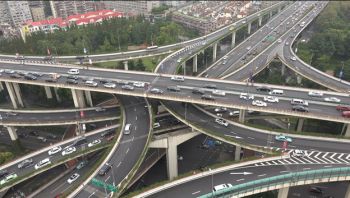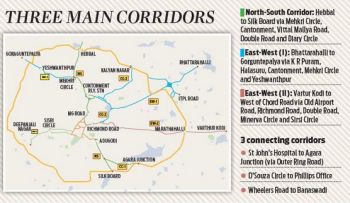

There is quite a mixed reaction from people about the state government's proposal for an elevated corridor in the city. While some advocate it vociferously, the others decry the proposal for being a crony capitalism model.
"The answer plainly is efficient public transport," said one resident. "And, in that 'the bus', the most versatile of the modes, is today incapacitated by the archaic Contract Carriage Act, disallowing the genuine public (as different from the "public sector") to come up with solutions - ZipGo being just one. Agreed civic activist Mukunda N: "Yes, it is right that the archaic contract carriage act is one of the main culprits. Because this commuter unfriendly act has a mafia that has developed under it. The bus owners are paying a hefty hafta to the transport department and the traffic police. These agencies have virtually formed a nefarious cartel leading to traffic hazards on a daily basis. BBMP cannot plan for a bus stand for these buses because it is illegal and therefore officially non-existent. This has been going on for more than a few decades. Needs cleaning up fast."
Resident Radhakrishnan chimed in: "Most countries with an efficient public transport system also have an excellent road network. It is a pleasure to drive on those roads. However, the public transport is so good that one chooses to take it. One big factor that works in its favour is good last mile connectivity. So u can’t and should not curtail car usage. Instead make public transport the obvious choice. And at the same time ensuring a good and efficient road network for those choosing to use it. For me that is the way forward."
Koramangala resident activist Nitin Seshadri had this to say: "Totally agree. Bangalore has about 1/3 of the road network it needs. Which means, we need roads and we need them quick. And since we can't get them by widening unless we are prepared to acquire, demolish and inflict misery all around, the only choice is to go vertical. It's not that the 35000 cr elevated roads we are talking about will be a silver bullet. But it's a start. An important step forward. And it's a step we should support."
Nitin does not stop there. "We also have too many people reading from American and European hymnsheets," he says. "Which is why the words like 'induced demand' and 'car driven model' get bandied about. We don't have a single study showing induced demand in India. We don't have a car driven model. At best we have a motor cycle model. (but as I said that sounds less sexy and won't win invitations to seminars in New York, so our academics don't want to go there !)."
HSR Layout's civic activist RS Murthy says that the project conceived over a decade ago should be understood in the right perspective: "Activists must realise the advantages accruing in implementation of this project. All right-thinking Bangaloreans should welcome this decision of the state government. Posterity will remember this. Everyone of us have experienced the inconvenience due to chaotic traffic all over the city's roads. I strongly feel that technical and design suggestions and changes can be resolved with the government across the table. The project must ensure safety and smooth traffic across Bangalore."
Pushpa S has a divergent view on this: "Why not regulate the petrol guzzling, pollution compounding and traffic jamming private vehicles on our roads? Yes, we need roads for so many categories of road vehicles - including buses - but the elevated roads will only cater to the private car owners because of the very nature of their construction! Of course, speedy improvement in public transport - Metro, Surburban Trains, Regular and Dependable Bus Service - are the projects that must be prioritized. After which, as in the other countries, people will prefer to use public transport because it will be less nerve-racking, more comfortable and more convenient and, finally, less expensive, too! That's the way to go, but it doesn't mean that those who are aged and infirm will be prevented from using their personal vehicles at all. It'll just mean that the numbers of pollution-producing vehicles will be brought down, and the resultant air pollution levels will allow us to live reasonably disease-free lives."
But R Ravindra disputes this: "On what basis do you say that only pvt vehicles will use the elevated roads? On the elevated road to electronics city, on Hosur road, all categories of vehicles except for autorickshaws use this road. Do only private cars fuel guzzle fuel or cause pollution? If that is a valid argument, then all vehicles, public or private should be drastically reduced on our roads. But that's obviously not possible. Helicopters as private vehicles are a soft target, hence they are relentlessly hammered. But they are hardly the elephant in the room! Incidentally, taxis and autorickshaws are also public transport. In Bangalore, Ola and Uber - to name just the biggies - contribute hugely to public transport."
There is news that buses which have a carrying capacity of about 16 times (average) that of a private car cannot use these corridors. But nothing is concrete yet. Says Ravindra: "There have been suggestions that buses be allowed on these elevated roads, with appropriate bus bays/ stops, with access to grade level below. Its improbable that there will be kilometres-long elevated roads in both the axes of the city and buses not be allowed on them. It will be hugely unpopular and governments are populist if nothing else. I think it is but fair to let the Karnataka government unveil its detailed plans for improvement of road infrastructure, examine its pros and cons in a pramatic manner before making pronouncements."
But architect Naresh Narasimhan doesn't think buses will be allowed on this corridor. "Buses need to stop every 1.5-2 kms (like metro), but that means a up/down ramp or an ugly elevated station( a la Metro)... it will never happen," he says.
Gayatri Kapur had another take on this: "Buses from point to point on elevated roads is not a bad thing ... if we can get from Silk Board to Hebbal in 30 min by bus, many would gladly use it instead of the car, but if the bus stops every 1.5-2km on the corridor, and it takes 1.5-2 hours, then how many will drop private cars?" And this is precisely why some residents feel that buses should not be allowed to have so many stops on the corridor, if they are allowed at all.
Nitin says, "This thought process of #beda (saying 'no') all the way is regressive. Build the infra. Stop further IT parks and large buildings in Bangalore. Build public transport and then disincentivize."
Ravindra agrees to this by saying, "Absolutely. Go the Mysuru way - they didn't become Bangalore's clone and hence Mysuru is still a livable city."
With arguments coming both in favour and against the elevated corridor project, the residents are asking the government to thrash out the differences, get the best experts from both sides and have a neutral jury to give their verdict on this proposal. Suffice it to say that the venerable Indian Institute of Science has questioned the usefullness of the project. Not to mention, the environmental impact of erecting a 102-kilometre six-lane elevated corridor criss-crossing the city. The argument continues while the people suffer from traffic chaos and 'moderate' pollution levels across the city.
